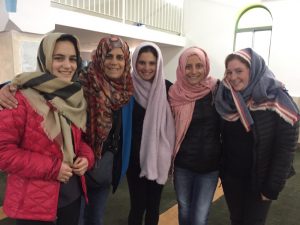W.H.D. – A Weekly Letter From Rabbi Davis – February 8, 2019
Shalom Chaverim
Earlier this week was World Hijab Day (WHD). To tell the truth, I had never heard of this before though it has been around since 2013. On our recent Israel trip, we marked our own Hijab Day when we visited an Israeli-Arab town just outside of Jerusalem. When we toured the mosque, the women in our group were asked to don a hijab. It was the first time for many of them and I think they appreciated the opportunity to learn- to learn how to put one on, to learn the symbolism of this head covering and to learn about Islam from our local guide. As the creators of WHD imagined, it helped foster religious tolerance and understanding. This is especially important for Jews and Arabs who share similar traditions but also have misgivings about each other.
 As in Islam, in Jewish tradition, the idea of women covering their hair is connected to notions of modesty. Hair, some rabbis suggest, is sexually erotic. They therefore prohibit men from praying in sight of a women whose hair is not covered. This prohibition is then extended beyond davening times and settings. Naturally, not everyone agrees. Writing in The Observant Life: The Wisdom of Conservative Judaism for Contemporary Jews, Rabbi Gordon Tucker explains:
As in Islam, in Jewish tradition, the idea of women covering their hair is connected to notions of modesty. Hair, some rabbis suggest, is sexually erotic. They therefore prohibit men from praying in sight of a women whose hair is not covered. This prohibition is then extended beyond davening times and settings. Naturally, not everyone agrees. Writing in The Observant Life: The Wisdom of Conservative Judaism for Contemporary Jews, Rabbi Gordon Tucker explains:
The body must not be treated as an instrument for sexual arousal and one must dress in such a way that the body will not play such a role. One must not demean the human being’s nobility by the exposure of nakedness in public. There is little if any argument in Jewish sources about this fundamental idea. And it is especially relevant in contemporary society, which has seen a transformation in standards of public modesty with the so-called sexual revolution of the 1960s. But if there is little disagreement in Jewish sources over the general principle underlying tz’niut, that of maintaining and preserving human dignity, the question of how specifically and practically to develop this value into law has created a wide spectrum of approaches that have, in turn, spawned a widely divergent set of behavior patterns in different segments of Jewish society.
The diversity of opinions and practices was true from Talmudic days to the middle ages modern days. One Talmudic opinion holds that this is a biblical commandment. Another posits that it is not one of the 613 mitzvot but that it has been accepted as an adopted communal norm. In good rabbinic fashion, the Talmud offers a compromise suggesting that the Torah requires at least some of a women’s hair to be covered. But medieval and modern rabbis evaluate this compromise position differently. Some are lenient do not require any head coverings. Others are strict and do not allow any hair to be shown. (Historically, the many references to this practice seem to indicate that it was a custom for women to cover their hair in Talmudic times.)
In our own Conservative movement and here at Beth El, the practice varies. Many women do not cover their hair and reject the entire premise on which the tradition is based. Some women see it as a pious custom and cover their hair when they ascend the bima. Others wear “feminine” kippot perhaps out of a desire to promote equality of practice with men. Still other women turn to hats as a fashion-forward way of connecting to Jewish tradition and celebrating their identity as Jewish women. According to our official policy, we invite but do not require women to cover their hair in shul.
In speaking about head coverings, Tucker writes, “Identifying as a Jew, and being reminded of that identity is of great value in the modern world, and this is especially so for those who live in cultures that seek to homogenize the differences among groups.” I imagine women who celebrated World Hijab Day would agree.
Bivrakha,
Rabbi Alexander Davis
adavis@bethelsynagogue.org
